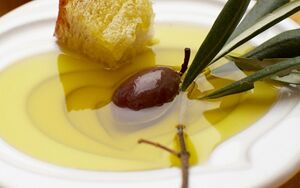Laghi Lombardi (Lakes of Lombardy olive oil)
DOP Laghi Lombardi is an Italian extra virgin olive oil with the following chemical and organoleptic characteristics:

Acidity: max. 0.55%
Peroxides: < 12 Meq02/kg
Colour: from green to yellow
Aroma: light-medium fruity
Flavour: fruity
Oleic acid: > 76%
The above values vary, although within very strict limits, for each of the geographic indications given in the production regulations.
The production area of "Laghi Lombardi" DOP olive oil is the municipalities located within the provinces of Brescia, Bergamo, Como and Lecco, near to Lakes Como and Iseo.
The growing of olives in the lake areas of Lombardy goes back to ancient times. The presence of olives is found in fossils from the Cretaceous period discovered in the southern area of the Alpine massif. In the Bronze Age the people living in pile-dwellings in settlements on the lakes used the fruit of the olive tree, as demonstrated by the olive stones found along with pottery remains in Pacengo. There are the remains of oil mills from Roman times in the lake areas, confirming the existence of a milling industry for olive oil production. Numerous historical documents from the Middle Ages onwards provide evidence of the presence of the olive in the area near the lakes. There are numerous references by Italian and foreign writers and poets, including Catullus, Goethe and D'Annunzio. The Lacini inquiry in 1882 gives a description of olive growing in Lombardy, indicating the area covered by specialised olive groves, harvesting methods, the preservation and milling of olives and the quality of the oil with the systems in use. From the time of the Lacini inquiry until today, olive growing in Lombardy has fluctuated due to changing economic and social conditions and especially to improvements in growing techniques.
Suitable olive trees are those on hills or at the foot of hills where the soil is derived from limestone and a variety of sedimentary materials. "Laghi Lombardi" extra virgin olive oil is produced from healthy olives, harvested by January 15 of each year. The per hectare yield of olives may not exceed 5 000 kg in the specialised olive groves, with a maximum oil yield of 19%. The olives are gathered direct from the tree, either by hand or by mechanical means. The only extraction methods permitted are those physical and mechanical processes which most faithfully preserve the particular and original characteristics of the fruit.
The link between olive oil production and the area of Lombardy in question is fundamentally justified by the particularly mild climate of the areas near Lake Sebino and Lake Lario which favour proper olive growing conditions and make possible an olive oil production with particular chemical and organoleptic characteristics (very low acidity, rich in phenols which mean the oil can be kept for a long time). The varieties used are principally Frantoio and Pendolino plus other, commoner, varieties (Leccino, Casaliva). Some very high quality varieties are also present (Gaggiolo on Lake Como, Bresa on Lake Iseo).
The Lacini report of 1882 mentioned previously describes olive growing in the area and places where seedlings are found, the preferred varieties and the methods used in planting, harvesting and preservation up until the time of delivering the olives to the "manufacturer". The growing of olives in this area, which stand up to difficult climatic, soil and mountainous conditions, also contributes to the beauty of the landscape and is evidence of an innate tradition in the customs of the local peoples, who have always considered olive oil as a very valuable product. The specification includes two adjacent geographical designations: "Laghi Lombardi Sebino" (Lake Iseo) and "Laghi Lombardi Lario" (Lake Como). These designations reflect different situations in practical terms. The need to permit the operators concerned to use these designations derives primarily from the goal of identifying more clearly where oil is produced since, while the quality of the oil is basically the same there are slight differences in the organisation and production systems between the two areas. In the Sebino area the olive tree is cultivated by owners on small areas of land, sometimes alongside other crops and processing takes place in a few jointly-owned mills. In the Lario areas, however, the holdings are rented and cultivated by farmers who process the oil in the only large mill in the area. These differences in manufacture result in slight variations in taste in the oñ produced which, although not readily apparent to consumers, justify a precise territorial designation.
Reference: The European Commission
#olive #olives #oliveoil #storecupboarditems #condiments #fruit